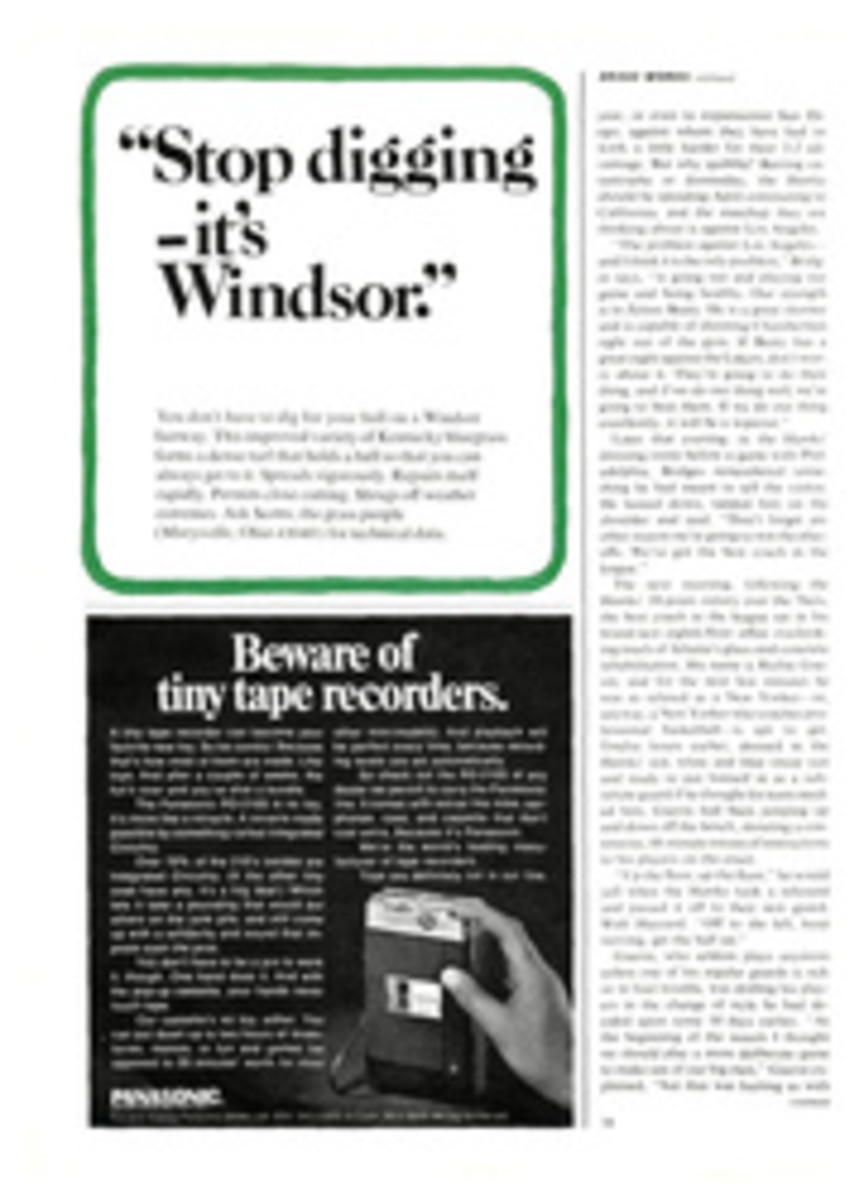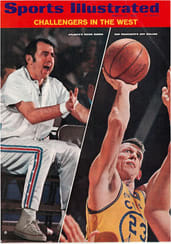
FROM MOUNTAIN TO MOLEHILL
Nelson Briles of the St. Louis Cardinals is a personable young man of 25 who, aside from being able to speak some Spanish, French and Russian, thinks a great deal about his career. As a starting pitcher for less than a season and a half, Briles has already won 29 games, not including one victory in the 1967 World Series. Last week at Al Lang Field in St. Petersburg, Fla., Briles ventured a few preseason comments on the state of the game. "This is a very unorthodox year for spring training," he said. "Everything seemed to hit at exactly the same time. There was the players' boycott, a period of long holdouts and a series of rule changes. It is all very confusing, especially to people trying to get themselves in shape for the start of the season."
In less than three weeks this already complicated season will indeed begin in earnest, complete with four new expansion teams, sub-league divisional play, a new commissioner and the hope that some hitting will offer improvement on a season of suffocating pitching excellence. The hope is based upon a major change in the rules: the lowering of the pitcher's mound from 15 inches to 10. It could have as profound an effect upon baseball as, say, widening the holes in golf or lowering the net in tennis. It already has caused more genuine spring training arguments, discussion and jokes than anything in years.
Five inches off the top of the mound may not sound like much, but when you walk into any training camp it looks as if a mountain has been turned into a molehill. From the stands and the dugout the mound, which used to rise like Mount Fuji in the middle of the infield, now resembles the Salt Flats of Utah. Many pitchers are grumbling often and loud while others just wink. The hitters say very little, because they know that when pitchers get angry anything can happen.
What has happened so far is that spring training has been a hitter's festival. Imagine 54 runs being scored in the first three games of the Arizona exhibition schedule, or the New York Mets pounding out 22 hits in a single game. And all those strikeouts that seemed so dominant last March and early April are now a relic. The games might not be any faster this year, but they certainly are more interesting. Sometimes they recall jai alai more than baseball.
A slight reduction in the strike zone and the experiment involving pinch hitters received more publicity during the off season than the lowering of the mound. Last year's strike zone was from the top of the shoulder to the bottom of the kneecap, but it is now from the armpit to the top of the kneecap. So far there is little evidence that the changed strike zone has had any effect at all, or that indeed the umpires are paying any attention to it. The idea of using a "designated pinch hitter" in place of the pitcher has certainly not been universally accepted, even as an experiment. (Many teams, particularly in the National League, believe that the pitcher should bat in spring training because he is going to have to hit for himself once the regular season begins.)
But the lowered mound has many of the game's theorists puzzled. Put simply, the mound is now only 10 inches higher than home plate. When a pitcher throws—and particularly a straight overhand pitcher—he finds the ground coming up to meet him a lot quicker than it did before, and he is thus off balance when he releases the ball. "The difference I have noticed is that most of the pitchers seem to be throwing high," says Larry Shepard, the manager of the Pittsburgh Pirates and a close student of pitching. When a pitcher throws high he often throws himself out of a job.
Mickey Lolich, the man who won three games to become the star of last fall's World Series for the Detroit Tigers, says, "My elbow has been bothering me this spring. I can't pinpoint exactly that it has been caused by the lowering of the mound but this is my 11th spring and I never had problems like this before. They've lowered the mound, changed the strike zone and said a pitcher can't go to his mouth. Are we pitchers the bad guys, the villains? Who is going to balance my salary if my earned run average goes up to 3.50?"
The mound was lowered to try to help return hitting to baseball, since 1968 was completely owned by the pitchers. Highlighted by the excellence of Denny McLain, who won 31 games for the Tigers, and also by Bob Gibson of the Cardinals, who pitched 13 shutouts, pitchers took charge from the very beginning. Only by putting on a strong surge late in the season did Carl Yastrzemski of the Red Sox lift his batting average to .301, the lowest figure to win a batting championship in the history of the game.
Mounds have never been standard in either height or shape even though the rule—1.04 in your Official Baseball Rules—clearly states that the infield shall be graded so that the baselines and home plate are level, with a gradual slope from the baselines up to the pitcher's plate, which shall be 15 inches [now 10] above the baseline level. Few umpires have ever actually measured the height of the mound in any given ball park, though presumably they will be more careful now. Ground crews, though, have always paid attention to the type of pitching staffs various teams have had and then tried to construct mounds to give home pitchers the best area on which to work. In recent years, for example, the Philadelphia Phillies always kept their mound low because their staff was essentially composed of sidearm and three-quarter-motion pitchers. Best proof of this pudding was Jim Bunning, who made excellent use of the low elevation.
Dodger Stadium in Los Angeles was always known as a high-mound ball park because the Dodgers had plenty of fastball pitchers and a team that seemed capable of mustering only one or two runs. Roger Nelson, the first choice of the Kansas City Royals in the American League's expansion draft, recalls pitching once in Dodger Stadium. "That mound must have been 36 inches high," he nostalgically claims, "and it was great, like stepping off a mountain. In Chicago the White Sox used to keep their mound only about six inches high and they had one of the best pitching staffs in the league. Their pitchers were used to it and it would mess up visiting pitchers. I'm sure they will have to raise it to get it up to 10 inches."
Stan Musial, who this year enters baseball's Hall of Fame at Cooperstown, leaned against the batting cage last week and looked out at the lowered mound. "It must help the hitters," he said. "When a man is standing at the plate against a sidearm pitcher he has no trouble picking up the flight of the ball. He should be able to see all the ball. An overhand pitcher firing down off a high mound is another matter. Heck, some of the mounds were built up so high in the past it was ridiculous. Some of them were up over 25 inches. If the new rule is enforced, then the batter will be hitting at a ball which is coming at him at a better angle to hit. The pitchers know this, because I have talked to some of them and they feel that the plate is farther away than it has been in the past."
Don McMahon of the Detroit Tigers has already noticed the difference this spring. "Look at the number of walks that are being given up," he said. "In some games there have been as many as 13 or 14. Many pitchers are high and wide. You really have to force yourself on the mound to get the ball down. During the season a pitcher who has to start forcing himself in the early innings is going to be awful tired in the late ones."
Washington's Camilo Pascual, a grand old warrior, has also noticed the difference this year, although he has pitched very well in two outings. "I'm having trouble forcing my arm and body down into the ball," he says. "It isn't a matter of getting stuff on the ball so much as getting oomph. I might go to the side-arm fastball more than in the past."
Probably the best assessments of the situation came from Pitching Coaches Billy Muffett of the Cardinals and Johnny Sain of the Tigers. "It is going to take a lot of work," said Muffett, "for some people to get used to this new mound. What happens if the hitters have great years and the pitchers bad ones? Will there then be another change?" Sain says, "The man who is well organized out on the mound will still be able to pitch well. A man who is not well organized will be in trouble."
Last week Pitcher Jim Hannan of the Senators revealed yet another facet of this strange spring training. "In 1968," he said, "the balls were softer than they had been before. Ken McMullen [Washington's third baseman] used to sit on the bench and squeeze the horsehide up into a lump on the outside of the ball. Nine of every 10 balls I picked up seemed to be soft. Heck, one day an umpire pushed on a ball and the horsehide came up so that he could hold it between his fingers like a pendant on a chain. This year the balls feel much, much harder." And that, of course, is all the pitchers need to hear.
PHOTO
A batter's view of the old and the new is demonstrated by Dave Giusti (39), who is standing on a 15-inch plastic slab designed for use inside field houses, and by Nelson Briles, who is five inches below on this year's mound.

